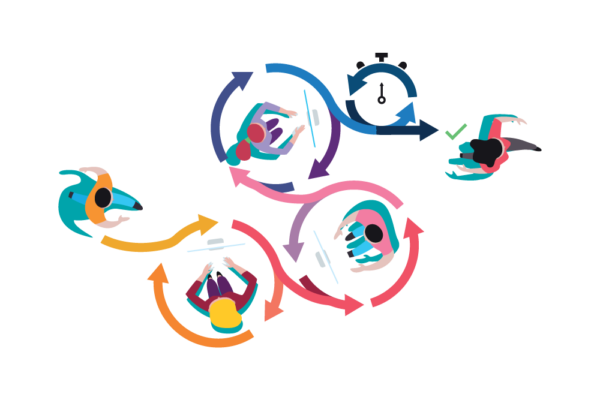Agile methodologies are nowadays going viral, but the attention is well deserved. When compared to traditional project management approaches, the Agile philosophy comes to shine with extraordinary levels of flexibility, adaptability and team collaboration. Agile thinking has even gone as far as kindling the spark to utilise these principles to transform entire companies. That’s how agile organizations began to appear not so long ago.
From my experience working in a bespoke software development company, I have the opportunity to observe the Agile principles in action on a daily basis. We at Dreamix develop custom software solutions for our business partners using trusted Agile methodologies to deliver high-value projects: bits by bits. One of the most distinguished benefits of implementing Agile for your next project is that you’ll experience increased process transparency with reduced risk and a high-quality product at the end.
Let’s see exactly how are these objectives achieved by taking a closer look at the six benefits of the Agile methodology.
1. Divide and Conquer: Roles and Responsibilities
In project management, it is essential to have clearly defined goals, responsibilities and roles. In Scrum, one of the most widely used Agile methodologies, the roles are as follows: developers, Scrum Master and Product Owner. The Scrum Team consists of a maximum of 10 people and is self-managing. Developers are responsible for delivering the work within a certain time-box. This is called yielding an ‘increment’, which is a valuable partial delivery for a software project.
The Product Owner (PO) role represents the interests of various stakeholders, including the customer. POs translates and prioritizes customer wishes into items on the Product Backlog (ultimate to-do list) and take responsibility for drawing up a Product Goal, client’s Return on Investment (ROI), or product’s value maximization. On the other hand, the Scrum Master role is there to guide the team and achieve optimal cooperation. Scrum Masters are process experts and make sure the team follows established Scrum guidelines. When extra training, additional workspace, software or hardware is needed, they are the ones who provide it, making sure the team can finish their tasks undisturbed.
2. Higher Flexibility Throughout the Project
At the initial project stages, clients are often not sure what their future business software should look like and what features should be included. Thus, at the beginning, business & product requirements are usually somewhat vague and then crystallise during the development process. Of course, clients already have an idea, but one of the leading initial tasks of the software development team is to be flexible and Agile methodology helps ensure this from day one. To arrive at a shared understanding of the bespoke software solution, the Agile development lifecycle happens in short intervals called Sprints.
On average, they last about two weeks each, and at the end, the development team shows the client what they have achieved. However, true flexibility unfolds because during regular meetings, both client and technical teams can decide what to do next based on the achieved results so far. This frequent software delivery helps clients see and understand if the current piece of software is what they need. If not, they have the chance to communicate their vision and modification suggestions early on.
3. Enhanced Adaptability Through Agile
Everyone can sense that the business world has drastically changed since the initial pandemic outbreak. Now the global focus is on digital transformation, highly personalised services and remote-first product delivery. As it turns out, the one thing that is for sure in the current unpredictable business landscape is that the changing circumstances require a great degree of flexibility. In order to stay competitive, businesses have to constantly re-adapt and quickly revise their success strategies on the go.
A proven way to do so is to use Agile methodologies such as Scrum or Kanban, as they have a very specific approach towards software development that yields the desired objectives. For example, Agile takes into account each project stage from all perspectives (business, technical, end-users) and wraps it up in individual user stories. However, the best idea from yesterday’s team meeting may sound inappropriate today, so each day the developers and the Product Owner gather to discuss ongoing progress and bring a fresh perspective to the project.
4. The Idea of Continuous Improvement
As human beings, we naturally strive to outperform ourselves and our previous achievements. This is exactly the thought behind Agile philosophy: to always look for ways to optimize existing software products and services, boost end-customer satisfaction and enhance the overall processes. In other words, Agile teams seize every opportunity that contributes to the continuous improvement of the software solution they’re currently working on.
In Scrum, there is a fixed meeting after each iteration (Sprint) called a Retrospective. Essentially, the Scrum team holds this meeting whenever the members check out a major project milestone. The main goal of the Retrospective is to reflect on the ongoing progress and achievements of the entire team. Discussions typically revolve around what went well, what didn’t and why. After identifying the bottlenecks, each team member has the opportunity to propose actionable steps that will help the team remove any obstacles.
5. Emphasis on Process Transparency
As I mentioned earlier, Agile methodologies concentrate on working transparently. The reason why process transparency is beneficial for project management is that it helps declare responsibilities, align team members and provide an overview of the current progress. Sharing valuable information and resources also bonds the team and allows them to collaborate more efficiently. On the other hand, this highlights the team’s accountability and involves everyone in the decision-making process.
Potential issues that might arise in case transparency is not practised or respected enough include misinterpreting project status, withholding valuable information from others, etc. The preferred approach in this case is to gradually increase internal transparency and move towards implementing it as a powerful mindset. Working with an Agile software development company makes all this so much easier than starting from scratch.
6. Next-Level Team Morale
The pandemic has revealed some repressed aspects of human nature such as the primordial fear that alarms our survival instinct. Whereas in 2020 many businesses struggled to stay afloat, paradoxically April 2021 marked the beginning of the Great Resignation when the record 4 million Americans quit their jobs according to statistical data.
As a result, companies face the fourth pandemic wave with the challenge to come up with ways to increase retention rates and, when possible, revive the team spirit. Boosting employee morale is one approach that businesses can try out to secure employees’ satisfaction. Agile methodologies are a great way to implement this long-term retention strategy as they help boost team collaboration, strengthening the sense of mutual trust and respect while delivering results through impeccable project management.
Author Bio:
Aleksandrina is a Content Creator at Dreamix, a custom software development company, and is keen оn innovative technological solutions with a positive impact on our world. Her teaching background, mixed with interests in psychology, drives her to share knowledge. She is an avid reader and an enthusiastic blogger, always looking for the next inspiration.
Read Dive is a leading technology blog focusing on different domains like Blockchain, AI, Chatbot, Fintech, Health Tech, Software Development and Testing. For guest blogging, please feel free to contact at readdive@gmail.com.





